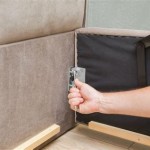How To Keep Cats From Scratching Leather Sofas
Leather sofas represent a significant investment, and maintaining their pristine condition can be challenging, especially for cat owners. A cat's natural instinct to scratch serves several purposes: sharpening claws, stretching muscles, and marking territory. Therefore, understanding and addressing these innate needs is crucial in preventing damage to leather furniture. Employing a multi-faceted approach that combines redirection, protection, and behavioral modification offers the best chance of preserving the integrity of the sofa.
Providing Alternative Scratching Surfaces
The primary strategy for diverting a cat's scratching behavior away from leather involves providing appealing and readily accessible alternatives. Cats are particular about the texture, stability, and location of their preferred scratching posts. Offering a variety of options increases the likelihood of finding something the cat finds attractive.
Scratching posts are available in a range of materials, including sisal, carpet, cardboard, and wood. Sisal is generally considered a highly desirable option due to its rough texture, which allows cats to effectively grip and remove dead nail sheaths. Carpeted posts can be attractive, but it is essential to avoid carpet that closely resembles the texture of the sofa, as this can inadvertently encourage scratching on the furniture. Cardboard scratchers are affordable and widely popular, particularly corrugated cardboard, which provides a satisfying shredding experience. Wooden posts offer a sturdy and natural alternative, though some cats may prefer softer materials.
Post stability is paramount. A wobbly or easily tipped post will likely be rejected by the cat. Opt for heavy-based posts or those that can be securely mounted to a wall. Height is also a crucial consideration. The post should be tall enough for the cat to fully stretch its body while scratching. This usually means a post that is at least 3 feet tall for an average-sized cat. If the cat prefers to scratch horizontally, a flat scratching mat or a low, wide post may be more appealing.
Strategic placement of scratching posts is essential for success. Observe where the cat currently scratches the sofa and position a post nearby. Cats often scratch after waking up or upon entering a room, so placing posts in these areas can capitalize on these natural tendencies. Make the posts even more enticing by rubbing them with catnip or spraying them with a commercial cat attractant. Positive reinforcement, such as offering treats or praise when the cat uses the scratching post, further encourages the desired behavior. Initially, it might be necessary to physically guide the cat to the post and gently demonstrate the scratching motion.
Protecting the Leather Sofa Directly
While redirecting scratching behavior is the ultimate goal, directly protecting the sofa can prevent further damage while the cat adjusts to the new scratching options. Several protective measures can be implemented, ranging from temporary solutions to more permanent alterations.
One option involves using physical barriers to make the sofa less appealing to scratch. Covering affected areas with blankets, sheets, or plastic sheeting can deter scratching by altering the texture and preventing the cat from getting a satisfying grip. While this may not be aesthetically pleasing, it provides immediate protection and allows the cat to adjust to the new scratching posts without causing further damage. Double-sided sticky tape can also be applied to the areas where the cat scratches. Cats dislike the sticky sensation on their paws and will typically avoid these areas. However, it is essential to ensure the tape is safe for the leather and does not leave any residue.
Commercial cat-repellent sprays are available that contain ingredients cats find unpleasant. These sprays often have citrus or herbal scents that deter cats from scratching. However, it is crucial to test the spray on an inconspicuous area of the sofa first to ensure it does not stain or damage the leather. Reapplication is necessary, as the scent will dissipate over time. It is important to note that some cats may be unaffected by these sprays, so their effectiveness can vary.
More permanent protective measures include applying furniture shields or guards. These are typically clear plastic or vinyl panels that attach to the corners and sides of the sofa, providing a physical barrier against scratching. They are available in various sizes and shapes to fit different sofa styles. While they may alter the appearance of the sofa, they offer a durable and effective solution for preventing damage. Another option is to have the leather professionally treated with a scratch-resistant coating. However, this can be an expensive solution, and it is essential to research the different types of coatings available to ensure they are safe for both the cat and the leather.
Addressing Underlying Behavioral Issues
In some cases, scratching can be a symptom of underlying behavioral issues, such as anxiety or boredom. Addressing these issues can help reduce the cat's overall urge to scratch and make it easier to redirect their behavior.
Providing ample playtime and enrichment can help alleviate boredom and reduce anxiety-related scratching. Cats need regular opportunities to engage in predatory behaviors, such as hunting, chasing, and pouncing. Interactive toys, such as feather wands, laser pointers, and puzzle feeders, can provide mental and physical stimulation. Spend at least 15-20 minutes each day playing with the cat, focusing on activities that mimic their natural hunting instincts. Cat trees and climbing structures can also provide vertical territory and opportunities for exercise, helping to reduce stress and boredom.
Creating a safe and comfortable environment can also help reduce anxiety. Ensure the cat has access to quiet and secure resting places where they can retreat when feeling overwhelmed or stressed. Providing multiple litter boxes, food and water bowls, and scratching posts in different locations can also reduce competition and territorial stress. Pheromone diffusers, such as Feliway, can release synthetic feline pheromones that have a calming effect on cats. These diffusers can be particularly helpful in multi-cat households or in situations where the cat is experiencing anxiety due to changes in the environment.
If the scratching behavior is severe or accompanied by other behavioral problems, consulting with a veterinarian or a certified feline behaviorist may be necessary. They can help identify any underlying medical or behavioral issues that may be contributing to the scratching and recommend appropriate treatment options. In some cases, medication may be necessary to manage anxiety or other behavioral problems. A behaviorist can also provide personalized advice on how to modify the cat's environment and behavior to reduce scratching and improve their overall well-being. They can also help differentiate between normal scratching behavior and compulsive scratching, which requires a different approach. Additionally, the placement of litter boxes, food, and water often affects how a cat marks its territory. Consulting a professional will help in this important area.

How To Keep Cats From Scratching Furniture Feliway

How To Fix Cat Scratch On Leather Couch Cozy Living

How To Repair Cat Scratched Leather The Interior Diyer

How To Repair Cat Scratched Leather The Interior Diyer

How To Protect Leather Furniture From Pets

Easy Cat Scratch Leather Repair

How To Repair Cat Other Scratches On Leather Material Von Baer

Do Cats Scratch Leather Reasons Prevention Hepper

Pet Furniture Damage Top 3 Common Repairs The Leather Doctor
How To Keep My Cat From Ruining Leather Couch Before It Gets Shredded Quora








